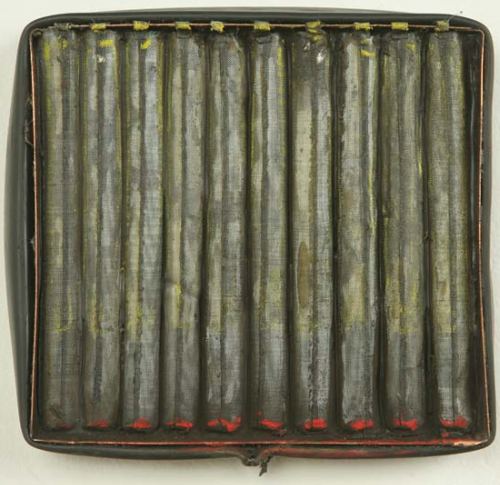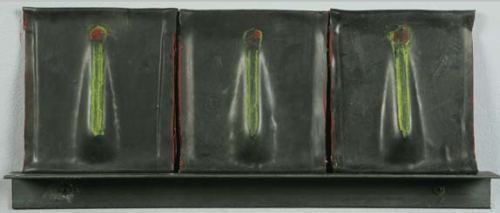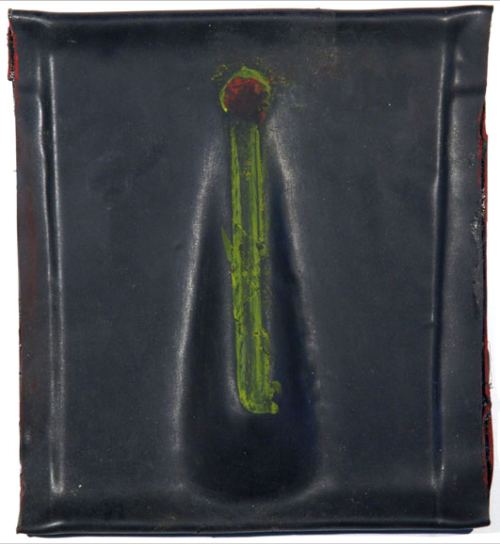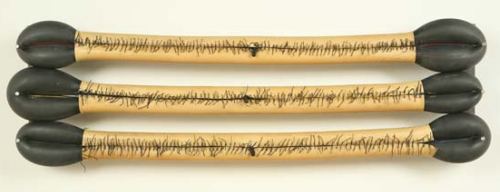Robert Mirenzi in earlier days:
In baking tins and
cardboard boxes painted to resemble baking tins, Robert Mirenzi’s loony assortment of
doll heads, doll hands and toy innards rise, as if full of yeast.
Some dolls are doubles of themselves, pink plastic casting plaster white
shadows. Some have lips sewn shut. Some are smeared with pale primary
paints. Tiny hands pop out of pull toys. Some heads are veiled, as if
wrapped to cool on a kitchen counter.
What distinguishes them from a century of similar surrealisms?
Their rigorous code, the structure that charges these oddball materials
with formalist rigor.
Mirenzi likes to start in the middle of a fairy tale and blunt all
suggestion of coherent narrative. The birds have eaten the crumbs
leading out of the forest. This point of paralysis inspires his art,
which is inventive, absurd and unforgiving. (via)
The toys are gone now. What’s left is what was there from the beginning, an industrial approach to aesthetic rigor inspired by the process artists of the 1970s. What he brings to their base is a comic air of insufficiency, a refusal to take up more space than he absolutely needs, an inclination to subtract rather than to add. Now that the dolls, frog’s legs and other broken toys are not there, it’s easy to see how unnecessary they were. For Mirenzi, the plainer, the better.
Nearly all of his current sculptures are small, from palm-size to arm’s length. Some sport some
kind of old metal frame or industrial pipe serving as frame.
Untitled mixed media construction, 2009
6 x 7 x 1¼
inches
 Whatever polish he brings to bear never obscures the down-and-out nature
Whatever polish he brings to bear never obscures the down-and-out nature
of his enterprise: funk on the cheap, industrial process sculpture
produced in the shadow of dying industries.
Color, usually an exhausted primary, is used sparingly.
Untitled mixed media construction, 2009
15 x 45½ x 7¼ inches
 Detail:
Detail:
 He is a poet of comic insufficiency – toys gone bad,
He is a poet of comic insufficiency – toys gone bad,
hobbies ridden off the deep end and work a delusion.
As a theme, insufficiency has inspired its share of art, but not often
visual art. Writers have claimed it (Dostoevski, Kafka, Samuel Beckett,
Richard Wright, Donald Barthelme) and actors have embodied it (Buster
Keaton, Peter Lorre, Al Pacino, Lily Tomlin) but even the most humble of
physical materials acquires authority when structurally organized into
an artwork.
Artists seeking to glorify the shabby, from Kurt Schwitters and Louise
Bourgeois to Robert Rauschenberg, invariably transform
it into focused beauty, even elegance. And art made from coarse
materials that does not rise to elegance usually lacks a compositional
imperative and for that reason is hard to consider art at all.
Untitled mixed media construction, 2009
8 x 19¼ x 1¼
inches Here’s where Mirenzi shines. He can
Here’s where Mirenzi shines. He can
manipulate his unlikely combinations of crafted and found objects into
sculptures whose aesthetic power never undermines their projected sense
of powerlessness.They limp along out of anyone’s spotlight, even their own.
At Francine Seders through March 14.



Leave a Reply